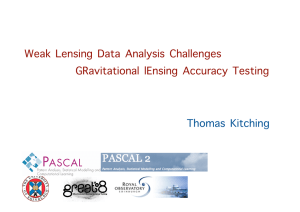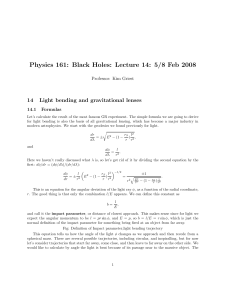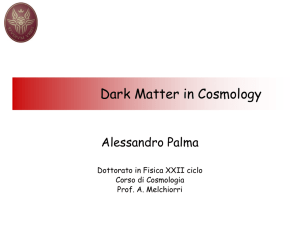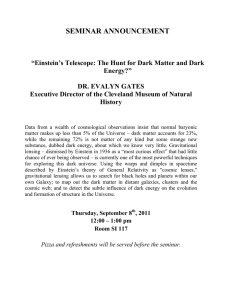The lens equation
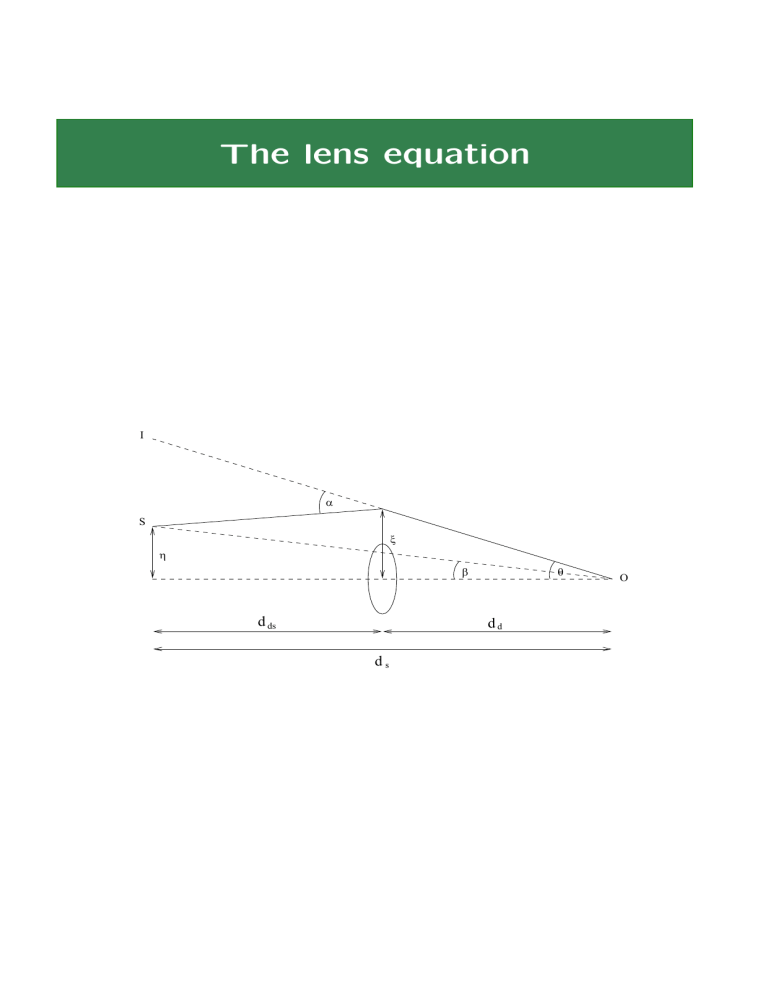
The lens equation
I
S
η d ds
α
ξ
β d d
θ
O d s
Gravitational lens systems
Abell 2218, Fruchter et al., WFPC2, HST, NASA
Leos Ondra
Background galaxies are multiple imaged and distorted into arcs by the massive foreground cluster.
Lens systems continued
King, NICMOS, HST, NASA
Leos Ondra
When the source and lens are perfectly aligned, an
Einstein ring forms where θ
E
∝ q
M ( < θ
E
).
Gravitational lensing phenomena
The three D:s of gravitational lensing:
• D elay ( ∼ ϕ )
• D eflect ( ∼ ∇ ϕ )
• D istort and magnify ( ∼ ∇
2 ϕ )
Observational quantities:
• D elay (galaxies) ≈ > ∆ t ∼ months
• D eflection (galaxies) α ∼ 1 arcsec
• D istortion (LSS) ≈ > ellipticities at %-level
Relevant scales
Applications (ordered by mass-scale):
• Femto-, pico-, nano-, micro, milli-lensing. . .
(where the prefix refers to α in units of arcsec)
• Galaxy lensing
• Cluster lensing
• Large scale structure lensing
• Cosmological parameters
For Ω
M
= 0 .
3 , Ω
Λ
= 0 .
7 , h = 0 of ∼ 6 kpc/arcsec at z = 0 .
5.
.
7 we have a scale
• 1 arcsec ∼ 6 kpc (small galaxy disc)
• 1 arcmin ∼ 0.36 Mpc (small galaxy cluster)
• 1 degree ∼ 22 Mpc ( ∼ 3 × 8 Mpc)
1 arcsec corresponds to moving a dot 0.5 mm on a wall 100 m away.
Microlensing
Time-dependent magnification of background sources.
Define a lensing cross-section : σ ∝ πθ
2
E
∝ M .
The optical depth is then given by:
τ ∝
Z n · σ · dV ∝ ρ
DM
.
(since n ∝ M − 1 and σ ∝ M ).
The time scale of the event is T ∝ M
1 / 2 v
− 1 f ( D )
(note the degeneracy).
The optical depth towards the LMC (for known stellar populations): τ ∼ 0 .
75 · 10
− 7
.
Microlensing continued
Ten years of operation from e.g. MACHO, EROS,
OGLE. . .
MACHO collaboration
One of the first microlensing events detected.
Results (the MACHO team) :
τ = 1 .
2 ± .
3 · 10
− 7
( τ ∼ 0 .
75 · 10 − 7 expected.)
⇒ Upper limit on the compact DM content of the
Milky Way of ∼ 20 %.
The no compact DM hypothesis within 2 σ of the measured result.
Cosmological parameters from lensing statistics
The larger the distance to a given redshift, the larger the number of lenses and the lensing probability.
JVAS/CLASS Survey Helbig (2000)
19 out of 9284 sources lensed.
0 .
1 < Ω
Λ
< 0 .
65 (95 %)
Caveats: lens modelling, observational bias. . .
Galaxy and cluster lensing
Lewis/Erwin
Strong lensing:
Large magnifications and/or multiple images.
Observables : Image configurations, time delays, statistics...
Parameters : Matter profile, H
0
, Ω
Λ
. . .
Weak lensing:
Small magnifications and distortion of images.
Observables : Bias, induced image ellipticities. . .
Parameters : Matter profile, Ω
M
. . .
Mapping dark matter halos
The field size is about 1.5 x 1.5 arcmin and the blue arc is a galaxy at redshift z = 2 .
24.
Using the Einstein angle θ
E
∝ q
M ( < θ
E
), we get
M ( < θ
E
) = 10
13
− 10
14
M
⊙
.
Strong lensing: Multiple image systems
First example of cosmological lensing:
QSO 0957+561(A,B) (1979)
(60 years after first lensing observation.)
00
00
00
00
To date, one has found ∼ 100 multiple quasars and measured ∼ 10 time delays with typical observables
• source redshift z s
∼ 2, lens redshift z d
∼ z s
/ 2,
• image separation ∆ θ ∼ 1
′′ and
• time delay between images ∆ t ∼ months.
Gravitational lensing time delay
The time delay has a geometrical and a potential part:
∆ t pot
= 2
Z
| ϕ | dl.
∆ t geo
= ∆ t geo
(Ω i
, H
0
) ∝ H
− 1
0
Small H(z)
00
00
00
00
Large H(z)
00
00
00
00
Do we constrain the lens or the cosmology?
Constraining the Hubble parameter
Assuming SIS halo ( ρ ∝ r
− 2
) profile, Kochanek and
Schechter (2003) derives:
H
0
= 48 ± 3 km/s/Mpc
Assuming constant M/L profile, the result is:
H
0
= 71 ± 3 km/s/Mpc
Apparently the degeneracy is a big problem!
Can we do better in the future?
Weak lensing
Lens mass density Induced shear ( γ )
Unlensed sources Lensed sources
Studying the ellipticities of background galaxies, we can map the dark matter!
Lensing from large scale structure
’Cosmic shear’ ( γ ) is particulary sensitive to Ω
M and σ
8
Divide the field into boxes of angular size θ .
Mean overall shear: Should be zero!
Shear variance: The variance of the mean shear in boxes of angular size θ .
Assuming no cosmological constant, and a single source redshift z , we have:
< γ ( θ )
2
>
1 / 2
≈ 1% σ
8
Ω
0 .
75 m z
0 .
8 s
θ
1arcmin
− n +2
2 where n is the spectral index of the power spectrum of density fluctua-
, tions.
Very weak signal compared to the intrinsic ellipticities of galaxies ( ∼ 30 %).
Shear variance results
Mellier et al.
Shear variance as function of angular scale. The open black stars illustrates the expected signal from a large survey covering 200 deg 2 .
Maoli et al. 2001
Cosmological results from 5 cosmic shear surveys represented as Ω m cl contour plots.
− σ
8
Summary
• Light beams are bent, independently of wavelength, as they pass massive objects, α =
4 GM b where b is the the distance from the light ray
, to the lens.
• Gravitational lensing from the Sun has been used to verify general relativity.
• Microlensing of stars in the Milky Way and neighbour galaxies are used to study the population of faint compact objects in the galaxy.
• Gravitational lensing from galaxies and galaxy clusters has probed the amount and distribution of dark matter in the halos and yielded estimates for the Hubble parameter.
• Multiple quasar image statistics constrain the cosmological constant and/or the lens models.
• Weak lensning from large scale structure constrains Ω
M and σ
8
.
